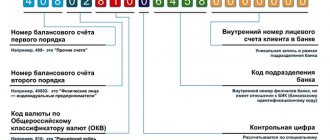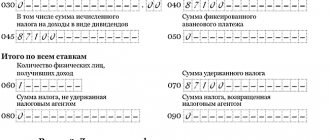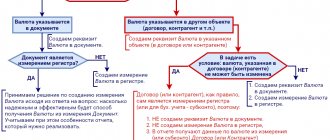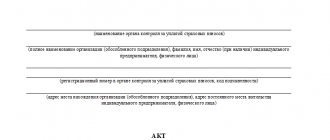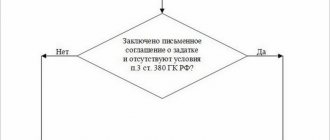In what cases is a collection order issued?
A collection order is a payment document for debiting funds from the payer’s account without his additional consent (indisputably). The Civil Code regulates the procedure for applying collection payments (Articles 874-876 of the Civil Code of the Russian Federation).
Collection orders are submitted to the account:
1) tax authorities and extra-budgetary funds if the deadline for fulfilling the requirement has expired;
2) bailiffs if there is a writ of execution for collection;
3) counterparties of the enterprise or individual entrepreneur, if there is an agreement with the condition of payment in an indisputable manner;
4) a bank conducting settlements for an organization or individual entrepreneur - for counterparties on the basis of their application and a writ of execution issued in connection with a court decision.
In any case, the use of a collection order is based on the recipient’s right to collect a certain amount of money from the payer (clause 7.4 of the “Regulations on the rules for the transfer of funds” No. 383-P, approved by the Bank of Russia on June 19, 2012).
What needs to be done for the “scheme” to work
If enterprises are interested in making payments between them without their direct participation, they need
- conclude an agreement between themselves in which it is required to include a clause on settlements through a collection order;
- submit this agreement to the servicing credit institution.
After the agreement is concluded and the transaction is completed, the supplier’s (seller’s) bank forwards the collection order to the consumer’s (buyer’s) bank. Then the bank notifies the buyer about receipt of the document for payment and, if confirmed, the transfer occurs, then the recipient's bank similarly informs its client about the crediting of funds to the account.
Difference from other payment documents
Let's look at how a collection order differs from other types of payment documents.
The payment order for the transfer of funds is filled out and presented to the bank for execution by the payer himself on a voluntary basis.
The payment request is made by the payee, but its presentation does not mean execution by the bank - the consent (acceptance) of the payer is often required to make the payment. If the payer disagrees, such a document will be returned to the recipient without execution. In certain cases, direct debiting of a payment request is also possible (by a court decision, on the grounds provided by law), incl. if the parties to the contract have agreed on this.
Calculations for collection and payment requests
Collection settlements are a banking operation through which the bank undertakes obligations to receive payment from the payer on the basis of documents submitted for collection. The essence of this operation is that the order to write off funds from the payer’s account is issued not by the payer himself, but by the recipient within the framework of the right granted to him.
Payments for collection can be carried out both with acceptance, i.e. when the payer confirms the documents submitted to his bank for the write-off of funds, and without acceptance - in cases established by law (as a rule, this applies to write-offs for executive and equivalent documents).
In modern practice, the collection form of payments is carried out on the basis of payment requests and collection orders. The specified documents are presented by the recipient of funds (collector) to the payer's account through the bank servicing the recipient.
A payment request is used, as a rule, in commercial transactions and is a settlement document that contains the requirement of the creditor (recipient of funds) under the main agreement to the debtor (payer) to pay a certain amount of money through the bank. Settlements with payment requests can be carried out with or without the payer’s acceptance. When making payments between commercial organizations, payment requests without acceptance are used only in cases where this condition is established by the main agreement between the counterparties, as well as if there is a condition in the bank account agreement between the payer and his bank about the possibility of debiting funds without acceptance. In business practice between commercial organizations, direct payment requests are used quite rarely. Basically, settlements are carried out by payment requests, paid with the acceptance of the payer. An application for acceptance or refusal of acceptance is drawn up on a special form. If the bank does not receive this document, then it will simply return the payment request, indicating on it that “consent to acceptance has not been received.”
Payment requests are submitted to the recipient's bank on the prescribed form. In addition to the basic details of payment documents (see above), the payment request must contain:
- payment terms (with or without acceptance);
- duration of acceptance (determined by the counterparties under the main agreement, but should not be less than 5 working days);
- the date of sending (delivering) to the payer the documents provided for in the main contract, indicating that the supplier has fulfilled the terms of the contract;
- name of goods, works, services; details of the main business agreement.
The recipient's bank (issuer) that accepts payment requests checks the compliance of the payment request with the established form, the correspondence of the recipient's signatures and seal, as well as the completeness of filling out all the details provided for in the form. If all rules are observed, 2 copies of the payment request with the register of payment requests (list of requirements for this payment and their main details) are transferred to the payer’s bank (executing bank). Payment requests received by the executing bank are checked for compliance of the terms of this form of payment with the terms of the agreement between the bank and the payer.
When settling payment requests with acceptance, one copy of the request is transferred to the payer for acceptance. The payment request can be accepted by the payer before the expiration of the acceptance period by submitting to the bank an application with a stamp and appropriate signatures. Based on the details specified in the request, the executing bank debits funds from the payer’s account.
If the payer refuses to accept (in whole or in part), then he submits an application in 3 copies to the executing bank, in which he indicates the reasons for the refusal with obligatory reference to the terms of the contract or the rule of law. In particular, this may be a discrepancy between the form of payment used and the terms of the concluded main agreement. In case of complete refusal of acceptance, payment requests and the payer’s statement of refusal with the corresponding marks of the executing bank are returned to the issuing bank for transfer to the recipient. In the case of partial acceptance, the original amount is circled in the payment request and the amount to be paid is indicated next to it in numbers and in words. An application for partial refusal and one copy of the payment request serve as the basis for debiting funds from the payer’s account. The second copy of the application is sent to the issuing bank for issuing funds to the recipient. All disagreements arising between the payer and the recipient are resolved by law.
If the executing bank does not receive the refusal to accept within the established period, the payment request is considered accepted and, based on the details specified in it, the executing bank makes the payment.
If the supplier submits a payment request to the issuing bank, which indicates that payment for it is carried out without the payer’s acceptance, then the request contains an indication of the clause of the main agreement, which provides for the following condition. Direct write-off under business contracts requires an appropriate indication of this possibility in the bank account agreement. In addition, when concluding a business agreement, the payer provides the bank servicing him with information about creditors (recipients) who have the right to submit payment requests for debiting funds without acceptance, as well as on the basis of which business agreements the said debit can be carried out. If there is no instructions on direct debiting of funds in the bank account agreement or the payer has not provided the bank with information about the recipients of the funds, the payment request is paid in accordance with the preliminary acceptance procedure. In case of direct debit of funds, if the executing bank complies with all legal requirements, the payer’s objections regarding the debit will not be accepted.
Collection payments can be carried out on the basis of collection orders. In accordance with current legislation, funds are written off under collection orders only in an indisputable manner. The Regulations on non-cash payments provide for the following cases of application of collection orders:
- when an indisputable collection procedure is established by law, including for the collection of funds by bodies performing control functions;
- when collecting on writs of execution.
Collection orders can also be used in settlements between commercial organizations if the terms of the main agreement, as well as bank account agreements, contain such a possibility. In this case, the document flow procedure is similar to the document flow when using payment requests-orders without acceptance. However, settlements using collection orders are used mainly for the forced collection of funds by the relevant state regulatory authorities. When collecting funds on the basis of writs of execution, the collection order must contain a reference to the date of issue of the writ of execution, its number, the number of the case on which the decision subject to enforcement was made, as well as the name of the body that made the decision.
The general scheme of settlements using collection orders and payment requests without acceptance is shown in Fig. 11.7.
Mandatory details of a collection order
Today, the established form of collection order 0401071 is used (Appendix No. 4 to Regulation No. 383-P). In addition to the general requirements for all payment documents for non-cash payments (date, number, amount, name of the payer and his TIN, KPP, bank details - bank name, BIC and bank correspondent account, recipient and his TIN, KPP, bank details), There are additional requirements for collection:
- In the purpose of payment:
If collection is issued on the basis of an agreement, indicate its number, the clause on the indisputable write-off procedure, as well as the name of the goods, works, services for which payment is made.
- When a collection order is issued on the basis of the law (for example, when tax authorities collect a fine), the name of the collection, the date, number and article of the federal law justifying the collection, the number and date of the decision on collection are indicated.
- The document based on the writ of execution indicates: the authority that issued the document, the date of the writ of execution, the number of the court case or materials.
The bank checks both the form itself and the applications. Execution of a collection order is carried out only if all formal requirements for the document are fulfilled. If they are not observed, the executing bank notifies the originator so that they can eliminate the shortcomings. If the collector has not corrected the shortcomings, the bank returns the collection order without execution (clause 1 of Article 875 of the Civil Code of the Russian Federation; clause 3 of Appendix 13 of the Regulations of the Bank of Russia “On the payment system of the Bank of Russia” dated 07/06/2017 No. 595-P).
Who is interested in the collection form of payment?
First of all, collection is beneficial to the buyer. This is due to the fact that he always retains the right to transfer the payment or refuse it (this determines the low reliability of these transactions). However, the seller can hedge his bets by pre-stocking certain documents, in the absence of which the buyer will not be able to take possession of the goods legally.
This is important to remember, given that this banking operation is carried out in conjunction with the acceptance of such a payment, which implies the immediate shipment of products under the current contract, regardless of whether funds have been received from the buyer or not. The buyer pays the price of the goods upon receipt of a complete package of payment documents, which must first be checked by the seller to ensure compliance with its cost, quality and quantity with the conditions specified in the contract.
The payment procedure by collection orders has one significant drawback: documents go through banks for quite a long time, so payment may not occur as quickly as we would like. Along with this, there is an advantage: in banks this service is quite cheap.
Collection orders from tax authorities
Most often, companies and individual entrepreneurs are faced with collection orders from tax authorities. In case of untimely payment of taxes and financial sanctions (fines, fines), the Federal Tax Service issues a demand to the debtor for payment, indicating the amount and date - by what date it must be fulfilled. If the taxpayer did not pay on time or did not challenge the legality of the claim (clause 3 of Article 46 of the Tax Code):
- no later than 2 months after the end of the period allotted for payment, a decision is made to recover funds;
- If more than 2 months have passed since the date specified in the request, a decision on collection can no longer be made, but the inspection has the right to go to court within six months.
Collection orders from tax authorities are usually received by the bank within 24 hours from the moment the decision on collection is made, and the amounts of money are written off without dispute. The Federal Tax Service must notify the taxpayer of the decision to collect payments within 6 days.
In addition to the collection order, tax officials usually send to the bank a decision to suspend transactions on the account for the same amount. In addition, in the presence of such restrictions, banks do not have the right to open a new current account for a taxpayer. Even if payment is made immediately, lifting the suspension may take a while.
Read also: Letter to the tax office about unblocking an account: sample
If there are insufficient funds in the account, the Federal Tax Service (and extra-budgetary funds) sends the bailiffs a decision to collect the amount due from the debtor’s property (Article of the Tax Code of the Russian Federation). Failure to comply with the bailiff's order within 5 days also entails the collection of an enforcement fee - 7% of the collection, but not less than 1,000 rubles from an individual entrepreneur and not less than 10,000 rubles from an organization (Article 112 of Law No. 229-FZ “On Enforcement Proceedings” dated 02.10 .2007).
Replenishment of an additional current account for the collection amount
If the tax authority refuses to meet the debtor halfway (and formally the Federal Tax Service has the rights
!), then there is nothing left to do but replenish an additional current account. It can be done:
- by depositing cash into the account;
- by means of non-cash transfer from the main account (if available);
- issuing invoices to counterparties with other details.
But each of the above methods has its disadvantages. Deposit cash
only possible if they actually exist. If the company is in a difficult financial situation, then it is also necessary to find or collect this amount. To do this, proceeds can be withdrawn from the company’s cash desk (if any), or a loan or loan can be issued from the business owner or manager. If the amount of unpaid taxes is large, then it may take a long time to collect the amount to pay the tax. Applying for a loan to a legal entity is a long process. In addition, the company must have large turnover in the account for the previous year.
The second option is to transfer money from the main account
. Most often, if a company failed to pay a tax or fee on time, it means that it does not currently have this amount. Otherwise the tax would have been paid.
It is worth noting that when a decision is made to suspend operations on an account, the collection amount is blocked on all of the company’s accounts and debited from only one. That is, the organization has the right to manage money the amount of which exceeds the blocking.
Example: The Federal Tax Service has blocked transactions on current accounts. The collection amount is 50 thousand rubles. One of the company’s accounts contains 65 thousand rubles. What amount is the LLC entitled to use?
The enterprise has the right to dispose of only 15 thousand rubles, since 50 thousand will be blocked until the collection amount is debited from the current account to which the collection order was issued.
The last option is issuing invoices to counterparties with other details
for payment. The main disadvantages here are time and additional documents. The organization needs to notify the buyer that their details for payment for goods, works or services have changed in a separate letter, which is sent either immediately when the details are changed, or together with a posted invoice for payment.
If in the future the company wants to issue invoices to counterparties using the old details, then you will have to draw up a repeat letter
.
Settlements by collection orders between counterparties
There are two types of collection according to calculations:
- clean collection – a bill or check is presented for payment;
- documentary collection – to make payment, transaction documents are required: agreement, delivery note (act), invoice, etc.
An agreement may be concluded between suppliers (executors) and buyers (customers), providing for the right of the supplier to receive funds from the buyer’s current account without his consent under certain conditions (for example, completion of the delivery of goods). A copy of the agreement is transferred to the servicing financial institution. When submitting supporting documents, the recipient's bank verifies the legality of the claim and, if everything is in order, transfers the collection order and documents to the payer's bank. The payer is notified about the transfer of funds, and the recipient is notified about their crediting.
Types of collection documents
The following types of collection documents are distinguished:
- clean collection, accompanied by a check or bill of exchange;
- documentary collection, represented by an act of acceptance of work (invoice for goods).
Having received a request from the client, the bank accepts the collection order for processing. That is, this is a payment request that is attached to the invoice of the paying company.
A similar operation in a bank occurs in combination with acceptance. This form assumes immediate shipment of goods under a valid agreement, regardless of the fact that payment for them has been received from the buyer. In this case, the buyer pays for the products upon receipt of all payment documents, after a preliminary check by the seller of the quantity, quality and price for compliance with the terms of the contract.
Features of compilation
Despite the similarity with a payment order, filling out collection documents has its own peculiarities. Collection must necessarily contain the following details:
- Link to the current legal act on the basis of which money is withdrawn. It is necessary to indicate the number and date of the regulatory legal act itself, the number of the article, clause or subclause.
- The number and date of the concluded agreement, agreement or contract, the number of the paragraph in which the possibility of carrying out this type of mutual settlements between counterparties is indicated.
- Details of the writ of execution and the name of the organization that issued the writ of execution. It is also necessary to indicate the number and date of the legal case.
Please note that if the requirements for details or the availability of supporting documentation are not met, the receiving bank must urgently notify the applicant that violations have been identified. If there is no action on the part of the applicant to eliminate the identified violations, the bank will refuse to execute the payment.
The collection order of the tax authority cannot be accepted for execution by the bank until the end of the period for voluntary repayment of the identified debt. In addition, the Federal Tax Service is obliged to issue payment requirements for withdrawal for each BCC separately; merging is not allowed. If an organization is subject to a penalty and a tax fine, then the Federal Tax Service is required to issue two collection orders: one for a penalty, the second for a fine, since each tax payment has its own individual budget classification code (BCC).
Settlements via payment request-order
These calculations are performed for purchased products or for services performed by the recipient of funds.
The advantages of this method of calculation:
- Reduced costs due to easier and less filling out of various papers.
- The responsibility for making payments between the supplier and the buyer increases significantly.
Disadvantages of this method:
- There is no 100% guarantee of payment from the payer.
- Debts may arise on both sides.
Nowadays, the current method of settlement agreements is not in demand, thanks to the development of commercial lending and the introduction of prepayment. This type of settlement was preserved only in collection orders.
Where can it be used?
The document is used in several cases:
- When an indisputable system for collecting money is established by law, even when collecting funds by control authorities.
- When collection is carried out according to enforcement documentation.
- In the case provided for by the contract, subject to granting the credit institution or individual the privilege to withdraw money from the account of this person without permission.
The collector of the money bears all responsibility for the correctness and legal basis for issuing the order. The bank may suspend the deduction in the event of a decision of the authority on the basis of the law, if there is a court decision on the suspension and other grounds in accordance with the law.
In what cases will all requirements be successfully met?
- The main condition for fulfilling a payment request is whether the payer agrees to fulfill it.
- The payer also decides whether to fulfill the obligations in whole or in part. All information about the decision made is filled in in the accepted document by the employee of the banking organization responsible for concluding the transaction.
- Payment settlement will be refused if the payer provides an acceptance with information different from the information that was specified in it by the recipient.
- You must fill out all the requirements. Corrections in the text, as well as the use of various means to cover up errors, are not allowed. If these rules are violated, the service will be refused, and all papers will be returned to their owner.
Watch the video tutorial 1C 8 3 on how to make a payment request:
We dispute the collection
Arbitration practice in disputes regarding the invalidation of collection orders sent to a bank outside the period established by the Tax Code of the Russian Federation is heterogeneous. There are decisions in which the courts have come to the conclusion that the deadline for sending a collection order is not preemptive. This means that failure by the tax authority to comply with this deadline does not have any legal consequences.
However, one may not agree with this position.
After all, if the legislator has established different deadlines for different stages of the procedure for extrajudicial collection of taxes (at the expense of money in bank accounts and at the expense of other property), then it is reasonable to assume that certain boundaries should be within these deadlines. If we approach this differently, it turns out that the tax authority can send collection orders to banks within the period allotted for collecting tax at the expense of other property. It follows from this that a collection order can be sent to the bank even after a year has passed after the deadline for voluntary compliance with the tax payment requirement has expired. That is, after it became impossible to make a decision to collect tax debt at the expense of other property.
There are also court decisions confirming the correctness of this approach. Agreeing with the arguments of taxpayers, the courts recognize the failure of tax authorities to comply with deadlines for sending collections to the bank as a violation, entailing the recognition of collection orders as invalid.
So, even if you missed the deadline for appealing the requirement to pay a tax (penalty, fine) or the decision to collect it, missing the deadline by the tax authority to send the collection order to the bank is your last chance to avoid collection by going to court with a request to invalidate this document .
Who issues it and how to fill out a collection order?
They differ from each other in the order and manner of execution:
- To make a payment under a payment order, the payer must agree to this. Therefore, upon receipt of this request, the bank is obliged to present it to the individual for acceptance. If the payer agrees with the payment, the document is signed by the authorized persons who manage the account and a seal is affixed. It is then paid using the funds in the payer’s account. If the person refuses to pay, the order will be returned to the recipient. If you agree to partial payment, you may need not only signatures and a seal, but also the entered amount, which must be debited from the account.
- Money is written off according to a collection document without acceptance, that is, the consent of the account owner is not required. Only notification of this operation occurs. These orders are issued by tax and customs authorities, as well as extra-budgetary funds and enterprises, based on the writ of execution of the arbitration court. They must be accompanied by documentation that confirms the eligibility of the exhibition. Only the licensee (collector) bears full responsibility for the legal issuance of this document and the correct indication of the grounds for collecting money.
If you are interested, read this material.
Information on what taxes the LLC pays is given. The essence of collection settlement is based on the fact that the bank, on behalf of the lender, receives payments from the payer after the provision of services.
Explain what is the difference between a payment request and a collection request (not from an order, but from a demand)?
It’s lazy, terribly lazy to quote the well-known legal acts - Regulations of the Central Bank of October 3, 2002 No. 2-p on non-cash payments in the Russian Federation, overcoming laziness, just for your sake Maria 9.1.
A payment request is a settlement document containing the request of the recipient of funds, submitted on the basis of an agreement with the payer, for the bank to write off funds from the payer’s bank account with his consent (acceptance of the payer). 9.2. Payment requirements are applied when making payments for goods supplied, work performed, services rendered, as well as in other cases provided for by the main agreement.
12.1. A collection order is a settlement document on the basis of which funds are written off from the accounts of payers: 1) in cases of collection of funds in accordance with the law, including for the collection of funds by bodies performing control functions; 2) for collection under enforcement documents; 3) in cases provided for by the parties to the main agreement, subject to the provision of the bank servicing the payer with the right to write off funds from the payer’s account. 12.3. The collection order is drawn up on form 0401071 (Appendix 13 to these Regulations). 12.4. When collecting funds from accounts in cases established by law, in the collection order in the field “Purpose of payment” a reference must be made to the law (indicating its number, date of adoption and the corresponding article).
12.5. When collecting funds on the basis of enforcement documents, the collection order must contain a reference to the date of issue of the enforcement document, its number, the number of the case on which the decision subject to enforcement was made, as well as the name of the body that made such a decision. If the enforcement fee is collected by a bailiff, the collection order must contain an indication of the collection of the enforcement fee, as well as a reference to the date and number of the enforcement document of the bailiff.
Collection orders for the collection of funds from accounts issued on the basis of writs of execution are accepted by the recovering bank with the attachment of the original of the writ of execution or its duplicate.
The difference is obvious, isn't it?
What is the difference between a payment order and a payment request?
- A payment order is one of the forms of non-cash payments, which is an order submitted by the account owner to the bank where his money is stored to transfer funds to another person.
- Bank payment demand - manifests itself as follows: the supplier demands from its buyer to pay the cost of the purchased product or service performed. In this case, the invoice is issued by the supplier, and the buyer must pay it.
The main difference between a payment order and a payment request is that in the first case, payment occurs by personal order of the account owner, and in the second, payment occurs by decision of the recipient.



